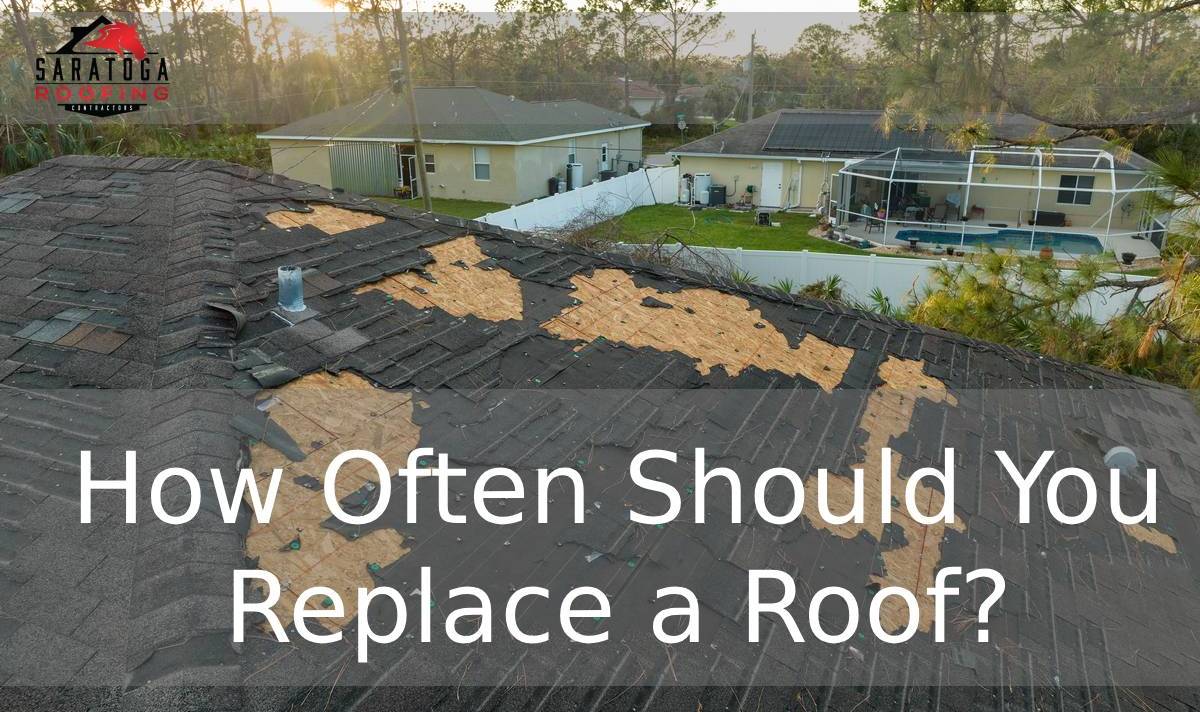
The frequency of roof replacement for USA homeowners typically ranges from 20 to 50 years, depending on the roofing material and environmental factors.
A roof’s lifespan depends on several factors, including the roofing material, environmental conditions, and maintenance.
On average, asphalt shingle roofs, one of the most common types in residential homes, last between 20 and 30 years.
Metal roofs can last 40 to 70 years, while tile or slate roofs often exceed 50 years with proper care.
Regular inspection and maintenance are critical for identifying potential issues that could shorten a roof’s lifespan.
Extreme weather, such as hail, heavy winds, or prolonged exposure to sunlight, can also accelerate wear and tear, requiring earlier replacement.
It’s essential to consult with a professional roofing contractor to evaluate your roof’s condition and determine if repair or replacement is necessary based on its age and any visible signs of deterioration.
Your roof is your home’s first line of defense against nature’s elements, protecting you from wind, rain, snow, and sun. But, like all good things, roofs don’t last forever.
Many homeowners grapple with this: how often should you replace a roof? Knowing the answer can save time and money and even prevent costly damage to your home.
This guide will explore everything you need to know, including the factors that affect a roof’s lifespan, warning signs that signal a replacement is due, and tips for maintaining your roof over time.
NOTE: Roof replacement frequency depends on the material of your roof, signs of wear, and environmental factors.
How Often Should You Replace a Roof? Key Factors to Consider
Not all roofs are made equal, and how often you replace yours depends on various factors. Material, climate, and maintenance are critical in determining a roof’s lifespan.
Below, we break down how often you should have your roof replaced based on each critical factor.
Roof Materials and Their Lifespan
The lifespan of your roof is heavily influenced by the type of material used. Here’s a breakdown of the expected lifespan of the most common roofing materials:
- Asphalt Shingles (Standard): 15-30 years
- Asphalt shingles are affordable but have a shorter lifespan compared to other materials.
- Architectural Shingles (Upgraded Asphalt): 25-50 years
- Architectural shingles are thicker and last significantly longer.
- Metal Roofing: 40-70 years
- Metal roofing provides durability and is ideal for areas with extreme weather.
- Clay Tiles: 50-100 years
- Prized for their longevity, clay tiles withstand heat and moisture effectively.
- Wood Shingles or Shakes: 20-40 years
- While beautiful, wood requires regular maintenance to prevent rot.
- Slate Roofing: 75-200 years
- Slate is one of the most durable materials but has a price tag.
How often do you need a new roof? It ultimately depends on the material you choose. Investing in longer-lasting options may reduce the frequency of replacements.
Climate and Environmental Conditions
The weather in your region significantly impacts how long your roof lasts.
Homes in areas with heavy snowfall, intense heat, or frequent storms often require more frequent roof replacements.
NOTE: Extreme weather accelerates wear and tear on your roof, reducing its functional lifespan.
- Cold Climates: Ice dams and heavy snow can damage shingles and create leaks.
- Hot Climates: Prolonged exposure to the sun can cause materials like asphalt shingles to curl and crack.
- Coastal Areas: Saltwater and moisture can corrode metal roofing and speed up deterioration.
Maintenance and Upkeep
Proper maintenance can extend the life of your roof by years. Ignoring minor issues like cracked shingles can lead to extensive and costly damage over time.
Here are a few tips to maintain your roof:
- Schedule regular inspections every 1-2 years to identify issues early.
- Clean out gutters to prevent water backup and roof leaks.
- Replace damaged shingles or tiles promptly.
- Trim overhanging tree branches to avoid debris buildup and damage during storms.
NOTE: A small investment in maintenance can postpone your next roof replacement by several years.
Warning Signs You Need a New Roof
One of homeowners’ most significant mistakes is waiting too long to replace their roofs. Here are the top signs that indicate it might be time.
1. Shingle Damage
Cracked, curling, or missing shingles are telltale signs that your roof needs attention.
Damaged shingles can no longer protect your home effectively, making your roof vulnerable to leaks and water damage.
NOTE: If more than 30% of your shingles are damaged, it’s likely time for a replacement.
2. Visible Leaks and Water Damage
Stains on your ceilings or walls often signal roof leaks.
Left unchecked, these can lead to mold growth and structural damage.
NOTE: Regular inspections can catch leaks early before they become major problems.
3. Sagging Roof
A sagging or droopy roof indicates structural issues, often caused by water damage or prolonged exposure to weight, such as heavy snow.
NOTE: A sagging roof is a severe problem that requires immediate action.
4. Age of the Roof
Even if there are no visible signs of damage, roofs should be replaced once they reach the end of their expected lifespan.
For instance, replacing a roof that uses asphalt shingles is around every 20-25 years.
When to Replace Roof Sheathing and Decking
While most homeowners focus on the visible part of the roof, the sheathing and decking beneath are equally critical. Here’s when to replace roof sheathing and decking:
- Water Damage or Rot: Inspect for signs of moisture—a soft spongy feeling or visible rot.
- Structural Issues: If the decking feels unstable or doesn’t provide proper support, it’s time for a replacement.
- Mold and Mildew: Mold growth on underside panels is a red flag indicating water intrusion.
NOTE: Neglecting roof decking issues can compromise the entire structure of your roof.
FAQ Section
1. How often should you replace a roof?
This depends on the material and maintenance. On average, asphalt shingles last 20-25 years, while metal roofs can last up to 70 years.
2. When should you replace the roof decking?
Replace roof decking if it shows signs of water damage, mold, or instability.
3. What is the cost of roof replacement?
Roof replacement costs vary based on size, material, and labor, typically ranging from $5,000 to $15,000 for asphalt shingles.
4. Can I replace only part of my roof?
Partial replacements are possible for isolated damage, but it’s often better to replace the entire roof for uniform wear and longevity.
5. How can I prolong the life of my roof?
Regular inspections, clearing gutters, and addressing minor issues promptly can extend your roof’s life.
6. What factors influence roof replacement costs?
Costs depend on material, roof size, complexity, and local labor rates.
7. Does homeowners insurance cover roof replacement?
Insurance may cover replacements due to storm damage but not normal wear and tear.
8. How do I choose the best roofing material?
Consider durability, climate, aesthetics, and budget when selecting roofing material.
9. Can I delay replacing my roof?
While minor repairs can postpone replacement, delaying too long risks severe water damage and higher costs.
10. Do new roofs improve home value?
Yes! A new roof can boost curb appeal and resale value significantly.
Don’t Wait Until It’s Too Late
Knowing how often you should replace a roof helps you plan and avoid costly emergencies. While the frequency will depend on factors like material, environment, and maintenance, looking for signs of damage can save you time and money in the long run.
If you’re unsure about the current state of your roof, consider hiring a professional from Saratoga Roofing Company for an inspection to gain peace of mind. Taking proactive steps today will ensure your home is secure and protected for years.
